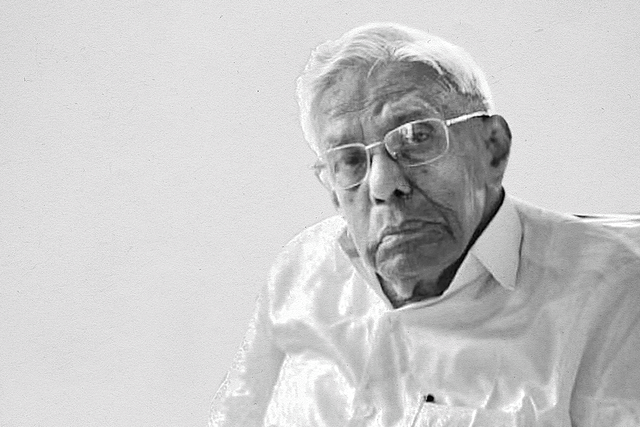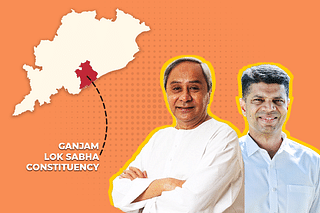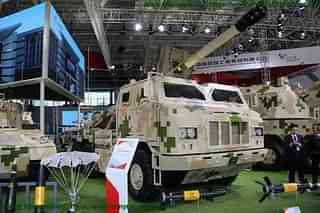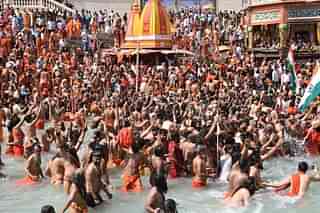Obit
R M Veerappan, The Quintessential Backroom Operator Of Tamil Nadu Who Impacted Politics Of MGR, Jayalalithaa And Rajini
K Balakumar
Apr 10, 2024, 03:58 PM | Updated Apr 11, 2024, 12:35 PM IST
Save & read from anywhere!
Bookmark stories for easy access on any device or the Swarajya app.

Though it may sound uncharitable and callous, but only when the news that he had passed away came, many probably realised that R M Veerappan had been alive till then.
For, the 98-year-old political and film veteran had so gone off the radar that many had come to the unfortunate conclusion that he had moved on in more ways than one.
But RMV, as he was generally known, was not the one to seek the headlines even when he was an all-powerful force in Tamil Nadu in the 1970s and early 1980s.
RMV, who was the force behind M G Ramachandran, first when he was a film star and later when he became a politician, was the quintessential backroom operator, who innately knew the weakness and strengths of politicians and actors, and played the cards accordingly.
His behind-the-scenes operations had an element of shadiness. But without which both cinema and politics wouldn't exist in this country. In a career that was long and tumultuous, RMV's influence had a huge say on the politics of three of the biggest personalities in Tamil Nadu — MGR, J Jayalalithaa and Rajinikanth.
RMV was a strange man who wore his complexities and contradictions with certain ease. He was a man who had direct tutelage under the Dravidian totems EVR and Anna, and yet RMV evolved into a person who once had a holy dip with the Kanchi Sankaracharya Chandrashekarendra Saraswati.
What RMV was as a person and what his ideas and ideals were really hard to fathom as he was a man of few words. But he made MGR, and later Rajinikanth, speak. And despite his ambitions and undoubted skills, he could never become the number one in Tamil Nadu politics.
That is because he did not have political acumen or the charisma to win the public's heart. For a man, who had been a cabinet minister five times in his career, and one who was a big-time producer handling some of the biggest stars in the industry, RMV had no great charm to his personality.
He was, in the succinct summary of political commentator Cho Ramaswamy, "a man best suited to be a co-pilot".
RMV Meets MGR, And The Rest Is History
Born in 9 September 1926 into a rich Chettiyar family, RMV, based on the various chronicles about him in the media, exhibited no remarkable or precocious qualities. But he was said to be so naughty and restless that he was sent to Singapore to a relative's place to dissipate his nervous energies.
When he was back, he grew a liking for stage plays and cinema, because of which he quit studies at school level. Soon enough he joined the famed TKS Brothers group (Kamal Haasan was among the popular products of this troupe later) first as a performer.
But in time, RMV showed a yen for managing and running the drama company. And as was inevitable in those times, the drama world was rife with Dravidian politics. RMV was also bitten by that bug. His resourcefulness ensured that he ended up having links with EVR and Anna. All these happened in the late 1940s and early 1950s.
But it was in 1953 that RMV's career marked the most momentous milestone. He formally joined forces with MGR who was the emerging name in Tamil cinema as well as politics.
It was the year MGR had become a member of the Dravida Munnetra Kazhagam (DMK), and as his time was taken up by acting and politics, he was looking for a trusted hand to run his own theatre group, the MGR Nadaga Mandram. Enter RMV, and Tamil Nadu politics and cinema would never be the same again.
RMV was the first one to fully understand the value of MGR as a brand. RMV, a consummate Chettiar who understood commerce and messaging, brought to the table the ethos of today's management personnel to Tamil Nadu politics and cinema.
He slowly decided how MGR's movies have to be chiselled to depict his larger political messages. His natural affinity for the Tamil language helped him pick the right kind of lyrics for MGR songs. MGR himself had a keen sense of music. But the importance of lyrics was an idea that he picked from RMV.
It was no coincidence that RMV had good vibes with all the lyricists who worked in MGR movies. He was the one who blooded Communist Pattukottai Kalyanasundaram into films through MGR's Nadodi Mannan (1958). It was he who when Kannadasn and MGR stopped seeing eye-to-eye built up Vaali to be the song-writer for him.
The year 1958 and the film Nadodi Mannan were crucial to both MGR and RMV. That movie, directed by MGR himself and among the costliest made then, set him on the firm course to stardom in cinema and politics. The story was carefully chosen to reflect his political ideals.
The film was made under the banner Emgeeyar Pictures, in which RMV was elevated to the post of managing director with a holding stake of 10 per cent. Only two other people were part of the board, MGR and his brother Chakrapani. The insignia of the banner was a man and a woman holding a flag in the red and black of DMK. This logo idea was the idea of RMV.
Since RMV understood how to project MGR's image, he was also roped in to be in charge of the story along with Vidwan Ve Lakshmanan and S K T Sami. MGR was confident that RMV will deliver what he had in mind. And the film's remarkable success proved that and their partnership grew from strength to strength.
The Man Behind MGR
All through the 1960s, RMV was MGR's be-all and end-all as he worked relentlessly behind the scenes to mould and shape the millions and millions of MGR fans into an association so that they could be used politically.
The DMK rode on MGR's film charisma and popularity. But to translate that into votes was the work of people like RMV, who was the president of the MGR Kazhagam (the parent body of his fans' associations).
RMV also had a hand in another seminal political event of the 1960s — the ouster of Kamaraj and Congress government, and the arrival of the DMK government into the portals of power.
Quite specifically, Anna had decided to not campaign against Kamaraj. The man pitted against Kamaraj in the Virudhunagar constituency was P Sreenivasan, a student leader in the DMK. Sreenivasan's campaign had no real momentum. As it happened, MGR was also in hospital recuperating after being shot by M R Radha.
It is here that RMV's natural campaign mastermind kicked in. He made MGR make an appeal from his hospital bed to the public through an advertisement in newspapers, the rest is history. Sreenivasan toppled the veteran Kamaraj, and Tamil Nadu politics has never been the same.
By the time MGR decided to branch out on his own with the All India Anna Dravida Munnetra Kazhagam (AIADMK), it was RMV who was with the star, plotting his every move and shaping his fledgeling party all through.
In 1977, when the AIADMK contested the state elections, it was RMV who was the brain behind its candidates' choice, its campaign and strategy. The party won a historic mandate, and MGR made RMV a minister in his cabinet even though he was at that time not part of either Legislative Assembly or the Legislative Council (he was later made a part of the Council).
It was RMV who helped MGR win in 1984 from the hospital in the US where he was undergoing treatment for kidney transplantation. As rumours spread in Tamil Nadu that MGR can no longer be active, it was RMV who made MGR put out a video from his hospital bed in Brooklyn. That shut down the devious campaign of the DMK on MGR's health.
RMV And Jaya Never Saw Eye To Eye
In the 1980s, RMV's second innings began, as it were as he had to cross swords with Jayalalithaa. Right through the 1970s, the political grapevine had it that it was RMV who kept MGR shielded from Jayalalithaa for the most part. RMV, a schemer in his own right, understood Jayalalithaa to be equally ambitious, and hence stood between her and his master.
In the 1980s, when MGR announced Jayalalithaa (who had been made the party's Rajya Sabha MP too at that time) as the propaganda secretary of the party, RMV knew that it was only a matter of time before she captured the AIADMK. As the notional second in command, he couldn't take it and he set out to stop MGR on his tracks.
Quite typically, he operated from behind the screens and orchestrated a revolt against MGR — something unthinkable in those days. The face of the revolt was Kalimuthu who alleged that Jayalalithaa was ratting out against MGR to the central government in Delhi.
The October of 1985 was so messy that MGR reportedly announced to a stunned cabinet, "I am resigning. Please elect some other leader of your choice." This extreme threat quelled the uprising in the party while MGR himself stepped back from announcing Jayalalithaa as his heir apparent.
But there was no real truce between RMV and Jaya. She constantly worked to get him out of the good books of MGR, and almost succeeded. She managed to get RMV sacked as minister in 1986, along with nine others under the guise of weeding out the slouches in the team.
But RMV did not give up and he had his own way of winning back MGR's confidence. In 1987, he was back with a ministership in MGR's cabinet —the only one among the 10 sent out in the earlier purge. The man's staying power was legendary.
But post MGR's demise in 1987, when the AIADMK split, RMV could have taken charge of one of the factions. But he never really took charge and instead chose to fire from MGR's widow R N Janaki’s shoulders. Janaki was no match for the dynamism of Jayalalithaa, and the latter soon captured the party on her own. With no MGR to fall back on, RMV found himself rudderless.
But he was a past master in political survival and chose to mend fences with Jayalalithaa, who also understood that she can't be totally antagonistic to him at that stage. So in 1991, when Jayalalithaa faced her first full election, RMV was on her side, and he won from Kangayam and became a minister in her team, besides being the joint general secretary of the party — a rarity in the Jaya era.
RMV, The Voice Behind Rajini’s Words
But Jaya and RMV knew each other well, and hence never truly trusted each other. In 1995, Jayalalithaa's regime had acquired a bad name for its corrupt and high-handed ways.
The law and order situation was also not encouraging. It was then that actor Rajinikanth criticised the Tamil Nadu government for failing to control the bomb culture in the state.
Not surprisingly, when the superstar made the comment RMV was on the same stage. A mighty miffed Jaya quickly dropped him from her cabinet, and later from the party itself. But RMV knew that a personality like Jaya's could be stopped only by someone like Rajinikanth.
RMV's equation with the actor goes back to 1981 when his production house Sathya Movies (yes, RMV had floated his cinema banner under the name of MGR's mother) made Ranuva Veeran.
RMV understood the spark in Rajinikanth and consistently backed him. He followed it with Moondru Mugam (1982), Thanga magan (1983), Oorkavalan (1987), Panakkaran (1990), and Baasha (1995). The last named is probably the most iconic of Rajini hits.
And it is in the aftermath of this film's mega success that Rajinikanth made that now famous bomb culture jibe against Jaya's government. Much later, Rajini also came out with the comment, "if you vote again for Jaya even God cannot save TN".
This was seen as the major reason for Jaya's government falling in 1996. The famed Rajini words were said to be done at the bidding of RMV. Or at least that was the popular belief.
By 2001 when Jaya famously made her comeback, she was very clear that she would not have RMV back, who by then had floated his own outfit MGR Kazhagam. His party contested in two seats as an ally of the DMK, and it lost both. RMV himself lost in Chennai's Alandur constituency.
That was his swan song in politics. Though he kept himself busy with film production and literary activities through Kambar Kazhagam, RMV was totally a spent force, and he had no interest or motivation to take on Jayalalithaa, who knew how to quell her rivals.
So all through the 2000s, RMV was away from the hurly-burly of Tamil Nadu politics and cinema. A man who liked to operate from the shadows was himself reduced to being a shadow of himself. By the time his death came yesterday (9 April), the news was a mere footnote in the high-octane election scene.
His fate, in a sense, is also a morality tale.
Save & read from anywhere!
Bookmark stories for easy access on any device or the Swarajya app.
Support Swarajya's 50 Ground Reports Project & Sponsor A Story
Every general election Swarajya does a 50 ground reports project.
Aimed only at serious readers and those who appreciate the nuances of political undercurrents, the project provides a sense of India's electoral landscape. As you know, these reports are produced after considerable investment of travel, time and effort on the ground.
This time too we've kicked off the project in style and have covered over 30 constituencies already. If you're someone who appreciates such work and have enjoyed our coverage please consider sponsoring a ground report for just Rs 2999 to Rs 19,999 - it goes a long way in helping us produce more quality reportage.
You can also back this project by becoming a subscriber for as little as Rs 999 - so do click on this links and choose a plan that suits you and back us.
Click below to contribute.





